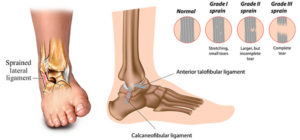Stop Ankle Sprains turning into Chronic Ankle Instability
November 13, 2017
We’re all bound to have sprained an ankle at some point in our lives, right? To varying degrees – perhaps you slightly rolled it and the pain went away after an hour or so, or perhaps you tore a ligament and ended up limping for days, if not weeks. Eventually, the pain does go away as the tears in the ligaments heal and the inflammation settles. But did you know that even though it may heal, if not managed properly, ankle sprains can leave a permanent impact on your ankle and your stability? It’s true and it happens more than you realise. Here’s what you need to know.
 Most ankle sprains are inversion ankle sprains, meaning that you roll onto the outside of your ankle, as opposed to the inside. This causes damage to the 3 main ligaments located at the lateral (outside) ankle, whose purpose is to provide stability and support (you have these stabilising ligaments on the inside of your ankle too). They are called your anterior talofibular ligament, posterior talofibular ligament and calcaneofibular ligament.
Damage to these ligaments presents as swelling, pain and tenderness on the outside of your ankle, with occasional bruising.
Most ankle sprains are inversion ankle sprains, meaning that you roll onto the outside of your ankle, as opposed to the inside. This causes damage to the 3 main ligaments located at the lateral (outside) ankle, whose purpose is to provide stability and support (you have these stabilising ligaments on the inside of your ankle too). They are called your anterior talofibular ligament, posterior talofibular ligament and calcaneofibular ligament.
Damage to these ligaments presents as swelling, pain and tenderness on the outside of your ankle, with occasional bruising.
What happens when you sprain your ankle?
 Most ankle sprains are inversion ankle sprains, meaning that you roll onto the outside of your ankle, as opposed to the inside. This causes damage to the 3 main ligaments located at the lateral (outside) ankle, whose purpose is to provide stability and support (you have these stabilising ligaments on the inside of your ankle too). They are called your anterior talofibular ligament, posterior talofibular ligament and calcaneofibular ligament.
Damage to these ligaments presents as swelling, pain and tenderness on the outside of your ankle, with occasional bruising.
Most ankle sprains are inversion ankle sprains, meaning that you roll onto the outside of your ankle, as opposed to the inside. This causes damage to the 3 main ligaments located at the lateral (outside) ankle, whose purpose is to provide stability and support (you have these stabilising ligaments on the inside of your ankle too). They are called your anterior talofibular ligament, posterior talofibular ligament and calcaneofibular ligament.
Damage to these ligaments presents as swelling, pain and tenderness on the outside of your ankle, with occasional bruising.
How does Chronic Ankle Instability develop?
Chronic Ankle Instability develops when proper care is not taken to treat and heal these ligaments. This means that following a sprain, instead of being effectively restored to the original strong, healthy ligaments they once were, the ligaments are left in a slightly weakened state, even though the pain and swelling have gone. Additionally, persistent swelling also contributes to the development of instability because a prolonged inflammatory process is damaging to tissues and ligaments. Typically, Chronic Ankle Instability develops and becomes symptomatic after repeated ankle sprains and ligament damage.What does having unstable ankles mean for me?
Instability impairs your balance, meaning you are more likely to have falls and repeated painful ankle sprains. Wearing unsupportive shoes like heels become more difficult, less stable, and far more tiresome for the other muscles and tissues through your feet and legs that will try to provide at least some compensation for your instability on your feet.What should you do?
The first and best thing you can do is ensure that you have adequate care for any sprains that you incur and that your ankles are effectively rehabilitated each time. If you’ve developed ankle instability, physical therapy can help you strengthen your ankle, improve your balance and retrain muscles. At Perform Podiatry, our Podiatrists develop a comprehensive, tailored treatment plan after a thorough biomechanical assessment of your feet and legs so we have the full picture of what is happening with your bones, joints, muscles and ligaments. In severe cases, we may need to use a brace to give you additional support throughout your rehabilitation. We set measurable goals and work to give you back as much strength and stability as possible. We also pair you with the right shoes for various occasions to get you the best outcomes. If you’ve suffered an ankle sprain or are worried you may have ankle instability, give us a call. We’re experts in foot health and biomechanics and are committed to delivering excellence in Podiatric care. Give us a call on 09 523 2333
